Fast food consumption Assignment
VerifiedAdded on 2021/06/17
|14
|3446
|8
AI Summary
Contribute Materials
Your contribution can guide someone’s learning journey. Share your
documents today.

FAST FOOD CONSUMPTIONS 1
Consumption of Food from Taking Away Places
Name:
Institution:
Course:
Tutor:
Date:
Consumption of Food from Taking Away Places
Name:
Institution:
Course:
Tutor:
Date:
Secure Best Marks with AI Grader
Need help grading? Try our AI Grader for instant feedback on your assignments.
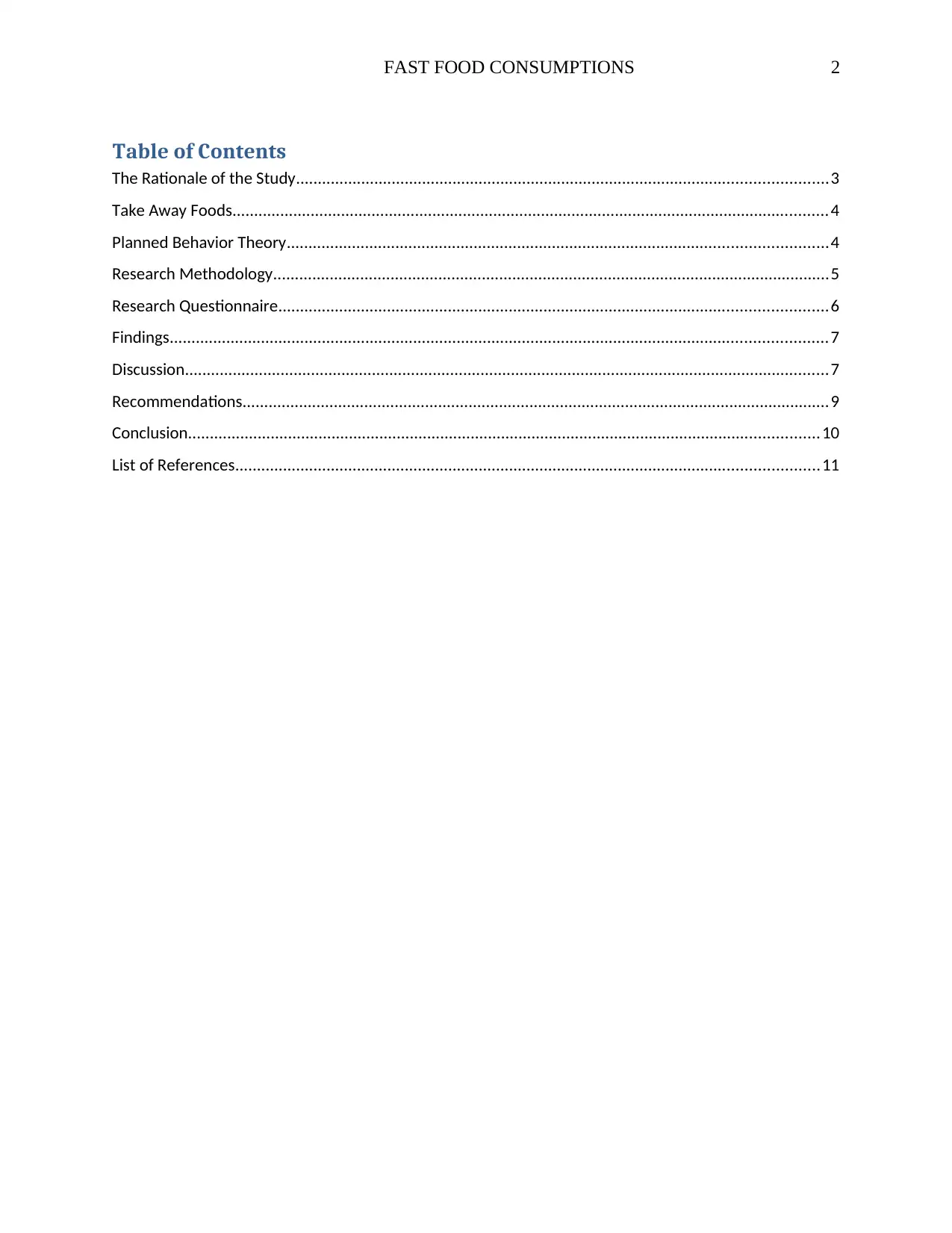
FAST FOOD CONSUMPTIONS 2
Table of Contents
The Rationale of the Study..........................................................................................................................3
Take Away Foods.........................................................................................................................................4
Planned Behavior Theory............................................................................................................................4
Research Methodology................................................................................................................................5
Research Questionnaire..............................................................................................................................6
Findings.......................................................................................................................................................7
Discussion....................................................................................................................................................7
Recommendations.......................................................................................................................................9
Conclusion.................................................................................................................................................10
List of References......................................................................................................................................11
Table of Contents
The Rationale of the Study..........................................................................................................................3
Take Away Foods.........................................................................................................................................4
Planned Behavior Theory............................................................................................................................4
Research Methodology................................................................................................................................5
Research Questionnaire..............................................................................................................................6
Findings.......................................................................................................................................................7
Discussion....................................................................................................................................................7
Recommendations.......................................................................................................................................9
Conclusion.................................................................................................................................................10
List of References......................................................................................................................................11
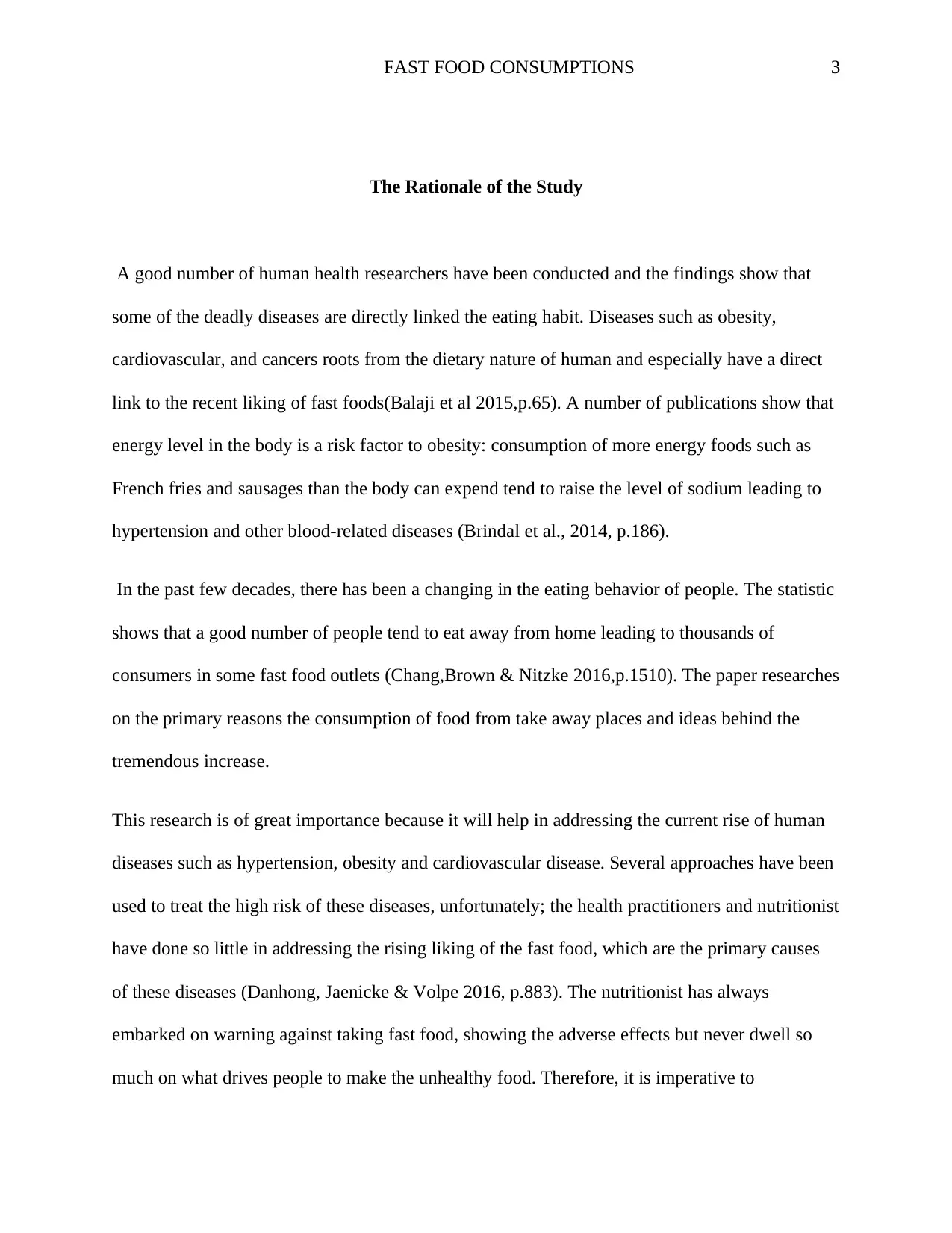
FAST FOOD CONSUMPTIONS 3
The Rationale of the Study
A good number of human health researchers have been conducted and the findings show that
some of the deadly diseases are directly linked the eating habit. Diseases such as obesity,
cardiovascular, and cancers roots from the dietary nature of human and especially have a direct
link to the recent liking of fast foods(Balaji et al 2015,p.65). A number of publications show that
energy level in the body is a risk factor to obesity: consumption of more energy foods such as
French fries and sausages than the body can expend tend to raise the level of sodium leading to
hypertension and other blood-related diseases (Brindal et al., 2014, p.186).
In the past few decades, there has been a changing in the eating behavior of people. The statistic
shows that a good number of people tend to eat away from home leading to thousands of
consumers in some fast food outlets (Chang,Brown & Nitzke 2016,p.1510). The paper researches
on the primary reasons the consumption of food from take away places and ideas behind the
tremendous increase.
This research is of great importance because it will help in addressing the current rise of human
diseases such as hypertension, obesity and cardiovascular disease. Several approaches have been
used to treat the high risk of these diseases, unfortunately; the health practitioners and nutritionist
have done so little in addressing the rising liking of the fast food, which are the primary causes
of these diseases (Danhong, Jaenicke & Volpe 2016, p.883). The nutritionist has always
embarked on warning against taking fast food, showing the adverse effects but never dwell so
much on what drives people to make the unhealthy food. Therefore, it is imperative to
The Rationale of the Study
A good number of human health researchers have been conducted and the findings show that
some of the deadly diseases are directly linked the eating habit. Diseases such as obesity,
cardiovascular, and cancers roots from the dietary nature of human and especially have a direct
link to the recent liking of fast foods(Balaji et al 2015,p.65). A number of publications show that
energy level in the body is a risk factor to obesity: consumption of more energy foods such as
French fries and sausages than the body can expend tend to raise the level of sodium leading to
hypertension and other blood-related diseases (Brindal et al., 2014, p.186).
In the past few decades, there has been a changing in the eating behavior of people. The statistic
shows that a good number of people tend to eat away from home leading to thousands of
consumers in some fast food outlets (Chang,Brown & Nitzke 2016,p.1510). The paper researches
on the primary reasons the consumption of food from take away places and ideas behind the
tremendous increase.
This research is of great importance because it will help in addressing the current rise of human
diseases such as hypertension, obesity and cardiovascular disease. Several approaches have been
used to treat the high risk of these diseases, unfortunately; the health practitioners and nutritionist
have done so little in addressing the rising liking of the fast food, which are the primary causes
of these diseases (Danhong, Jaenicke & Volpe 2016, p.883). The nutritionist has always
embarked on warning against taking fast food, showing the adverse effects but never dwell so
much on what drives people to make the unhealthy food. Therefore, it is imperative to

FAST FOOD CONSUMPTIONS 4
understand the significant reasons that encourage people to change the eating behavior from
home to take away places, to solve the increasing rate of food-related diseases.
Aim of the Study
The research paper tries to understand the nature of fast food consumptions that have been
rampant in the today’s human eating habits. At the end of the research, we will be able to
identify the reasons that push people to have fast food rather than eating from home.
Take Away Foods
Take away foods or commonly known as fast food refers to food items that are prepared in
places that have fast preparation and services, of which they are consumed away from the place.
The foods are always prepared to target that individual that have limited time to drink a good diet
either because of work, or class related issues (Jernigan et al.2017, p.443). High energy level
always characterizes these foods, hence overconsumption leading to increasing in weight. As the
technology advances, food processing has become common in most of today’s industries,
thereby making food more convenient for people hence creating more liking than homemade
food(Patel et al. 2017,p.9). These food prepared away from home tend to contain more energy
than those developed at home, thus leading to increased weight in the consumers.
Planned Behavior Theory
The method of expected behavior is the most used to describe the change of individual behaviors
as it adopts the cognitive approach to examine behaviors. The argument was evolved from the
understand the significant reasons that encourage people to change the eating behavior from
home to take away places, to solve the increasing rate of food-related diseases.
Aim of the Study
The research paper tries to understand the nature of fast food consumptions that have been
rampant in the today’s human eating habits. At the end of the research, we will be able to
identify the reasons that push people to have fast food rather than eating from home.
Take Away Foods
Take away foods or commonly known as fast food refers to food items that are prepared in
places that have fast preparation and services, of which they are consumed away from the place.
The foods are always prepared to target that individual that have limited time to drink a good diet
either because of work, or class related issues (Jernigan et al.2017, p.443). High energy level
always characterizes these foods, hence overconsumption leading to increasing in weight. As the
technology advances, food processing has become common in most of today’s industries,
thereby making food more convenient for people hence creating more liking than homemade
food(Patel et al. 2017,p.9). These food prepared away from home tend to contain more energy
than those developed at home, thus leading to increased weight in the consumers.
Planned Behavior Theory
The method of expected behavior is the most used to describe the change of individual behaviors
as it adopts the cognitive approach to examine behaviors. The argument was evolved from the
Paraphrase This Document
Need a fresh take? Get an instant paraphrase of this document with our AI Paraphraser
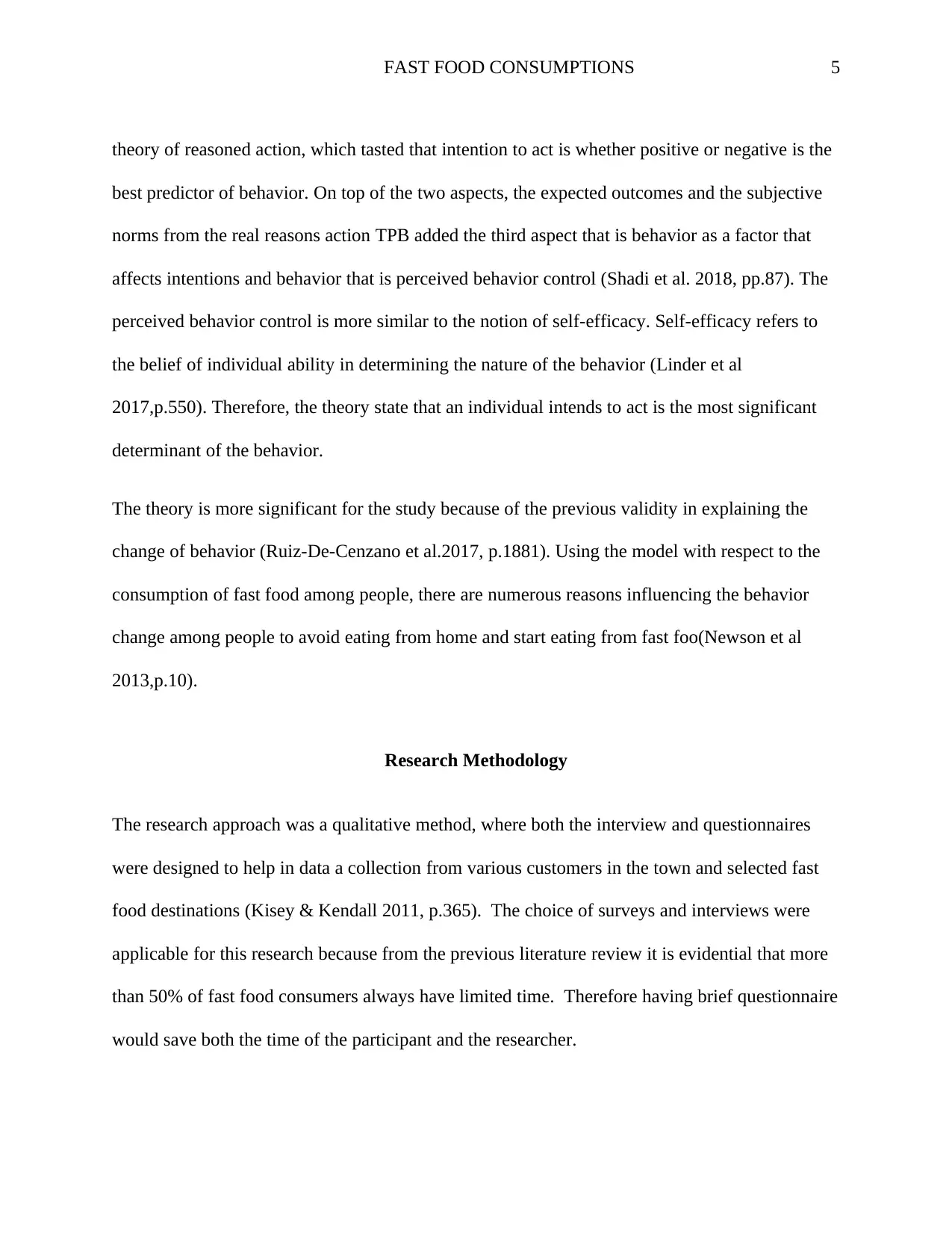
FAST FOOD CONSUMPTIONS 5
theory of reasoned action, which tasted that intention to act is whether positive or negative is the
best predictor of behavior. On top of the two aspects, the expected outcomes and the subjective
norms from the real reasons action TPB added the third aspect that is behavior as a factor that
affects intentions and behavior that is perceived behavior control (Shadi et al. 2018, pp.87). The
perceived behavior control is more similar to the notion of self-efficacy. Self-efficacy refers to
the belief of individual ability in determining the nature of the behavior (Linder et al
2017,p.550). Therefore, the theory state that an individual intends to act is the most significant
determinant of the behavior.
The theory is more significant for the study because of the previous validity in explaining the
change of behavior (Ruiz-De-Cenzano et al.2017, p.1881). Using the model with respect to the
consumption of fast food among people, there are numerous reasons influencing the behavior
change among people to avoid eating from home and start eating from fast foo(Newson et al
2013,p.10).
Research Methodology
The research approach was a qualitative method, where both the interview and questionnaires
were designed to help in data a collection from various customers in the town and selected fast
food destinations (Kisey & Kendall 2011, p.365). The choice of surveys and interviews were
applicable for this research because from the previous literature review it is evidential that more
than 50% of fast food consumers always have limited time. Therefore having brief questionnaire
would save both the time of the participant and the researcher.
theory of reasoned action, which tasted that intention to act is whether positive or negative is the
best predictor of behavior. On top of the two aspects, the expected outcomes and the subjective
norms from the real reasons action TPB added the third aspect that is behavior as a factor that
affects intentions and behavior that is perceived behavior control (Shadi et al. 2018, pp.87). The
perceived behavior control is more similar to the notion of self-efficacy. Self-efficacy refers to
the belief of individual ability in determining the nature of the behavior (Linder et al
2017,p.550). Therefore, the theory state that an individual intends to act is the most significant
determinant of the behavior.
The theory is more significant for the study because of the previous validity in explaining the
change of behavior (Ruiz-De-Cenzano et al.2017, p.1881). Using the model with respect to the
consumption of fast food among people, there are numerous reasons influencing the behavior
change among people to avoid eating from home and start eating from fast foo(Newson et al
2013,p.10).
Research Methodology
The research approach was a qualitative method, where both the interview and questionnaires
were designed to help in data a collection from various customers in the town and selected fast
food destinations (Kisey & Kendall 2011, p.365). The choice of surveys and interviews were
applicable for this research because from the previous literature review it is evidential that more
than 50% of fast food consumers always have limited time. Therefore having brief questionnaire
would save both the time of the participant and the researcher.
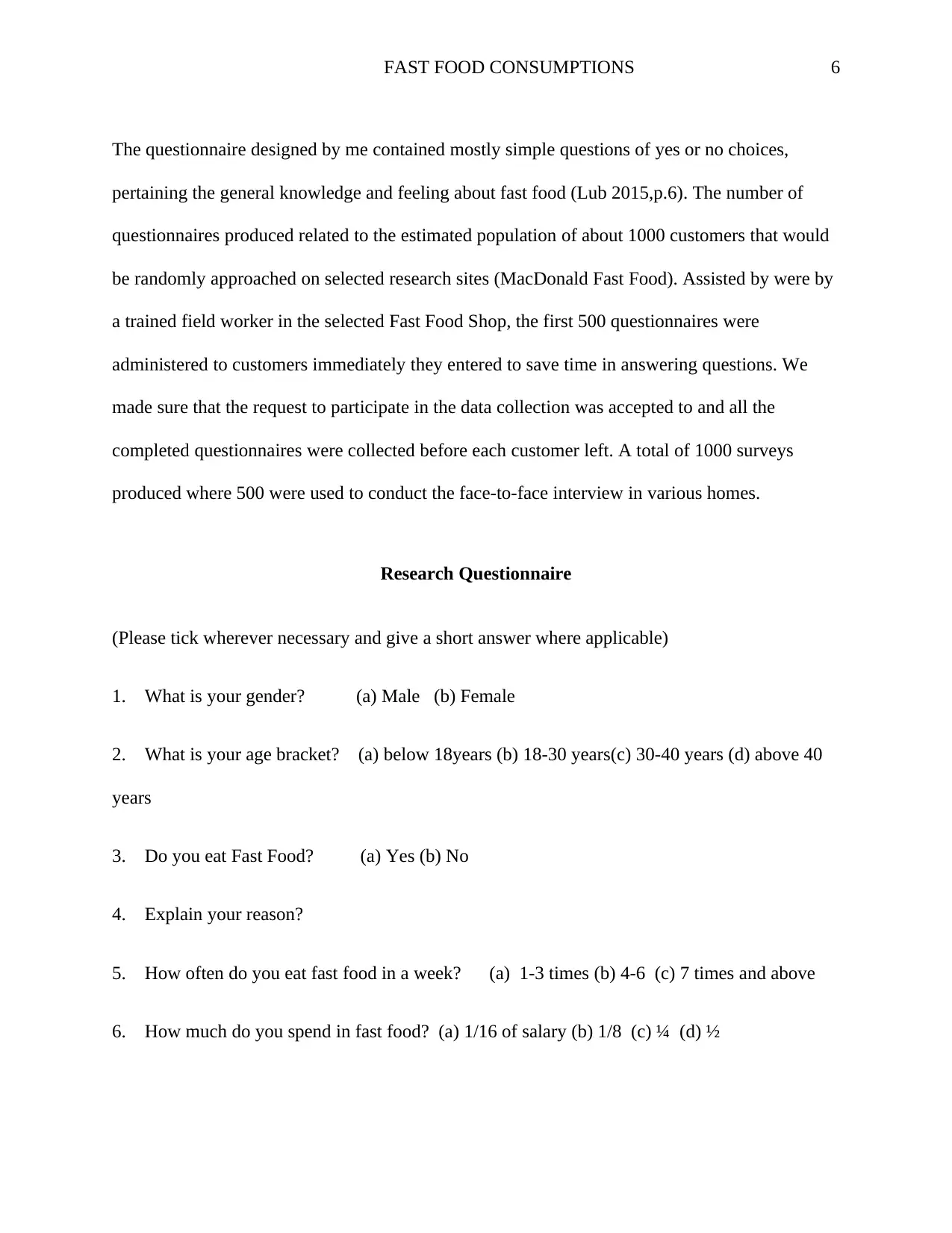
FAST FOOD CONSUMPTIONS 6
The questionnaire designed by me contained mostly simple questions of yes or no choices,
pertaining the general knowledge and feeling about fast food (Lub 2015,p.6). The number of
questionnaires produced related to the estimated population of about 1000 customers that would
be randomly approached on selected research sites (MacDonald Fast Food). Assisted by were by
a trained field worker in the selected Fast Food Shop, the first 500 questionnaires were
administered to customers immediately they entered to save time in answering questions. We
made sure that the request to participate in the data collection was accepted to and all the
completed questionnaires were collected before each customer left. A total of 1000 surveys
produced where 500 were used to conduct the face-to-face interview in various homes.
Research Questionnaire
(Please tick wherever necessary and give a short answer where applicable)
1. What is your gender? (a) Male (b) Female
2. What is your age bracket? (a) below 18years (b) 18-30 years(c) 30-40 years (d) above 40
years
3. Do you eat Fast Food? (a) Yes (b) No
4. Explain your reason?
5. How often do you eat fast food in a week? (a) 1-3 times (b) 4-6 (c) 7 times and above
6. How much do you spend in fast food? (a) 1/16 of salary (b) 1/8 (c) ¼ (d) ½
The questionnaire designed by me contained mostly simple questions of yes or no choices,
pertaining the general knowledge and feeling about fast food (Lub 2015,p.6). The number of
questionnaires produced related to the estimated population of about 1000 customers that would
be randomly approached on selected research sites (MacDonald Fast Food). Assisted by were by
a trained field worker in the selected Fast Food Shop, the first 500 questionnaires were
administered to customers immediately they entered to save time in answering questions. We
made sure that the request to participate in the data collection was accepted to and all the
completed questionnaires were collected before each customer left. A total of 1000 surveys
produced where 500 were used to conduct the face-to-face interview in various homes.
Research Questionnaire
(Please tick wherever necessary and give a short answer where applicable)
1. What is your gender? (a) Male (b) Female
2. What is your age bracket? (a) below 18years (b) 18-30 years(c) 30-40 years (d) above 40
years
3. Do you eat Fast Food? (a) Yes (b) No
4. Explain your reason?
5. How often do you eat fast food in a week? (a) 1-3 times (b) 4-6 (c) 7 times and above
6. How much do you spend in fast food? (a) 1/16 of salary (b) 1/8 (c) ¼ (d) ½

FAST FOOD CONSUMPTIONS 7
7. What affect your choice of fast food? (a) Branding (b) income (c) peer pressure (d) (e) Price
(f) Quick Service (g) Consumption Time (h) taste (i) others, specify
8. Do you have any food at home that can be prepared instantly?
9. Does fast food affect your health? (a) Yes (b) No
10. If yes, would you mind stopping taking fast food? (a) Yes (b) No
11. Explain your answer to question 9.
Findings
On the projected 1000 participants, there were about 847 respondents, a representation of 84.7%.
80% of the respondents tend to eat fast food and are consumed by all people irrespective of the
sex; however, females have a high percentage of about 56%. 30 % of the respondents consume
averagely 4-6 times a week, while 10% consume seven times a week. Among those who take
seven times and above a week spend like ¼ of the salary in fast food as they rarely eat from
home, while those who eat ones to thrice a week spend 1/16 of the salary.
It is also found that branding, social class, income, the order of the day, stress and emotions level
are significant contributors to fast food liking. As much as half of the respondents know very
well the negative impacts of fast food, ¾ is not likely to change the eating behavior reason being
the schedule, the taste, and peer pressure.
7. What affect your choice of fast food? (a) Branding (b) income (c) peer pressure (d) (e) Price
(f) Quick Service (g) Consumption Time (h) taste (i) others, specify
8. Do you have any food at home that can be prepared instantly?
9. Does fast food affect your health? (a) Yes (b) No
10. If yes, would you mind stopping taking fast food? (a) Yes (b) No
11. Explain your answer to question 9.
Findings
On the projected 1000 participants, there were about 847 respondents, a representation of 84.7%.
80% of the respondents tend to eat fast food and are consumed by all people irrespective of the
sex; however, females have a high percentage of about 56%. 30 % of the respondents consume
averagely 4-6 times a week, while 10% consume seven times a week. Among those who take
seven times and above a week spend like ¼ of the salary in fast food as they rarely eat from
home, while those who eat ones to thrice a week spend 1/16 of the salary.
It is also found that branding, social class, income, the order of the day, stress and emotions level
are significant contributors to fast food liking. As much as half of the respondents know very
well the negative impacts of fast food, ¾ is not likely to change the eating behavior reason being
the schedule, the taste, and peer pressure.
Secure Best Marks with AI Grader
Need help grading? Try our AI Grader for instant feedback on your assignments.

FAST FOOD CONSUMPTIONS 8
Discussion
From the study it is evidential that most of the fast food consumers range from 30 years and
below while the above 40 years tend to be more conscious about their health, hence just a few
consume fast food. Among the youths that form the largest market for fast food, females tend to
drink more of them than the male counterpart, the reason being the peer pressure and the social
class of the consumers. Generally speaking, 79 percent of respondents said they ate fast food in
any event once amid the three weeks (Warrens 2015, p.128). Separating it by salary deciles
(gatherings of 10 percent of total family unit wage) did not demonstrate enormous contrasts.
Among the most elevated tenth of workers, around 75 percent revealed eating fast food at any
rate once in the period, contrasted and 81 percent for the poorest. Workers in the center were the
greatest devotees of fast food, at around 85 percent. Most of the women reported that it was the
fashion among girls to be taking light foods such as sausages, French-fries among others, then
taking heavy food(Sisnowski,Street & Merlin 2017,p.8). However, the notion is much different
from the male counterparts that only consume fast food in the presence of the lovers or as opted
by their friend, otherwise most of them tend to love heavy food.
From the study, it is noted that the large group falls between the age of 30 and below, of which
some are still in school while some are newly employed hence do not have enough time to go
and prepare food at home(Thornton,Jeffery & Crawford 2013,p.2108). The fast foods have quick
service as compared to the meals from the restaurants that one has to make an order and wait for
Discussion
From the study it is evidential that most of the fast food consumers range from 30 years and
below while the above 40 years tend to be more conscious about their health, hence just a few
consume fast food. Among the youths that form the largest market for fast food, females tend to
drink more of them than the male counterpart, the reason being the peer pressure and the social
class of the consumers. Generally speaking, 79 percent of respondents said they ate fast food in
any event once amid the three weeks (Warrens 2015, p.128). Separating it by salary deciles
(gatherings of 10 percent of total family unit wage) did not demonstrate enormous contrasts.
Among the most elevated tenth of workers, around 75 percent revealed eating fast food at any
rate once in the period, contrasted and 81 percent for the poorest. Workers in the center were the
greatest devotees of fast food, at around 85 percent. Most of the women reported that it was the
fashion among girls to be taking light foods such as sausages, French-fries among others, then
taking heavy food(Sisnowski,Street & Merlin 2017,p.8). However, the notion is much different
from the male counterparts that only consume fast food in the presence of the lovers or as opted
by their friend, otherwise most of them tend to love heavy food.
From the study, it is noted that the large group falls between the age of 30 and below, of which
some are still in school while some are newly employed hence do not have enough time to go
and prepare food at home(Thornton,Jeffery & Crawford 2013,p.2108). The fast foods have quick
service as compared to the meals from the restaurants that one has to make an order and wait for
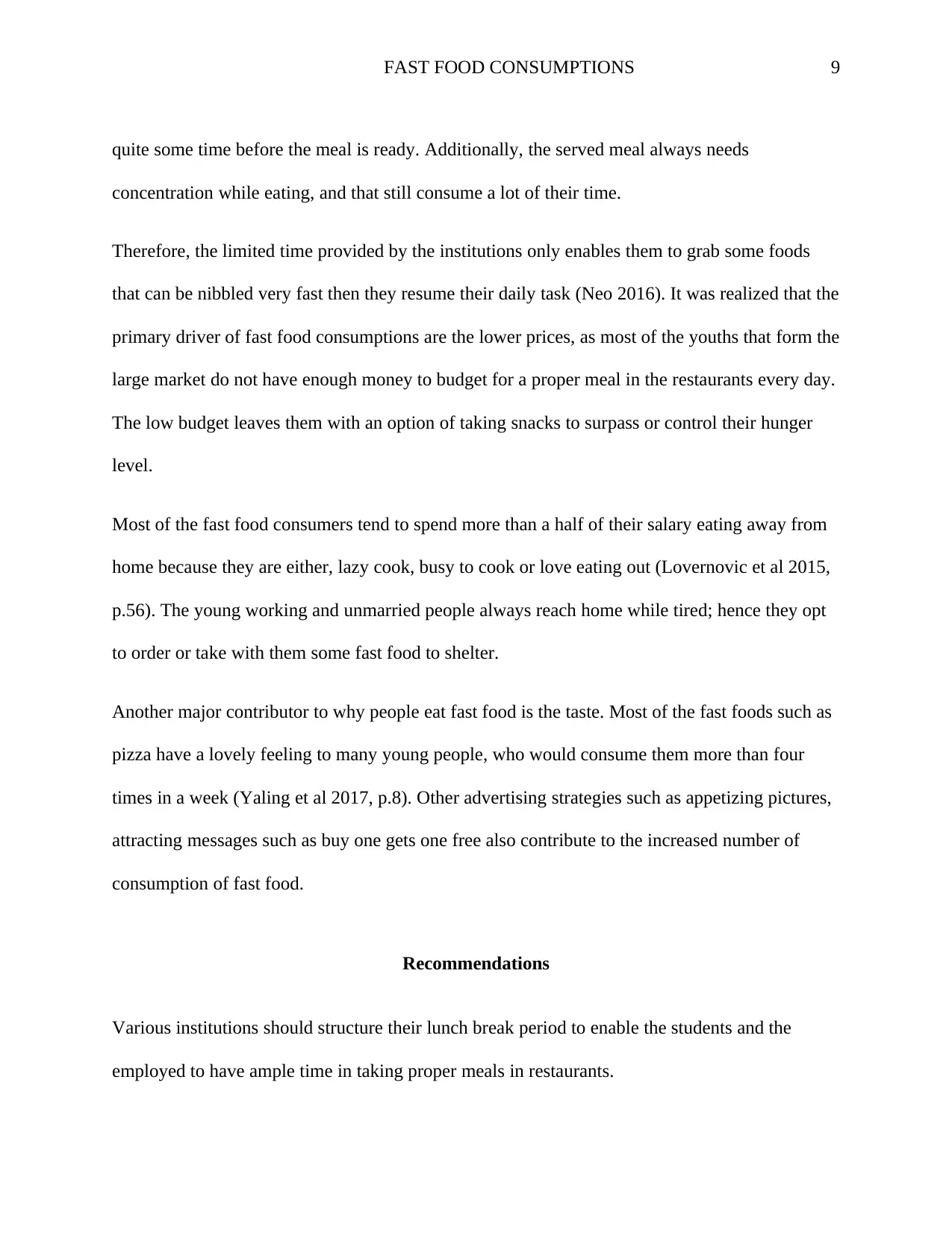
FAST FOOD CONSUMPTIONS 9
quite some time before the meal is ready. Additionally, the served meal always needs
concentration while eating, and that still consume a lot of their time.
Therefore, the limited time provided by the institutions only enables them to grab some foods
that can be nibbled very fast then they resume their daily task (Neo 2016). It was realized that the
primary driver of fast food consumptions are the lower prices, as most of the youths that form the
large market do not have enough money to budget for a proper meal in the restaurants every day.
The low budget leaves them with an option of taking snacks to surpass or control their hunger
level.
Most of the fast food consumers tend to spend more than a half of their salary eating away from
home because they are either, lazy cook, busy to cook or love eating out (Lovernovic et al 2015,
p.56). The young working and unmarried people always reach home while tired; hence they opt
to order or take with them some fast food to shelter.
Another major contributor to why people eat fast food is the taste. Most of the fast foods such as
pizza have a lovely feeling to many young people, who would consume them more than four
times in a week (Yaling et al 2017, p.8). Other advertising strategies such as appetizing pictures,
attracting messages such as buy one gets one free also contribute to the increased number of
consumption of fast food.
Recommendations
Various institutions should structure their lunch break period to enable the students and the
employed to have ample time in taking proper meals in restaurants.
quite some time before the meal is ready. Additionally, the served meal always needs
concentration while eating, and that still consume a lot of their time.
Therefore, the limited time provided by the institutions only enables them to grab some foods
that can be nibbled very fast then they resume their daily task (Neo 2016). It was realized that the
primary driver of fast food consumptions are the lower prices, as most of the youths that form the
large market do not have enough money to budget for a proper meal in the restaurants every day.
The low budget leaves them with an option of taking snacks to surpass or control their hunger
level.
Most of the fast food consumers tend to spend more than a half of their salary eating away from
home because they are either, lazy cook, busy to cook or love eating out (Lovernovic et al 2015,
p.56). The young working and unmarried people always reach home while tired; hence they opt
to order or take with them some fast food to shelter.
Another major contributor to why people eat fast food is the taste. Most of the fast foods such as
pizza have a lovely feeling to many young people, who would consume them more than four
times in a week (Yaling et al 2017, p.8). Other advertising strategies such as appetizing pictures,
attracting messages such as buy one gets one free also contribute to the increased number of
consumption of fast food.
Recommendations
Various institutions should structure their lunch break period to enable the students and the
employed to have ample time in taking proper meals in restaurants.
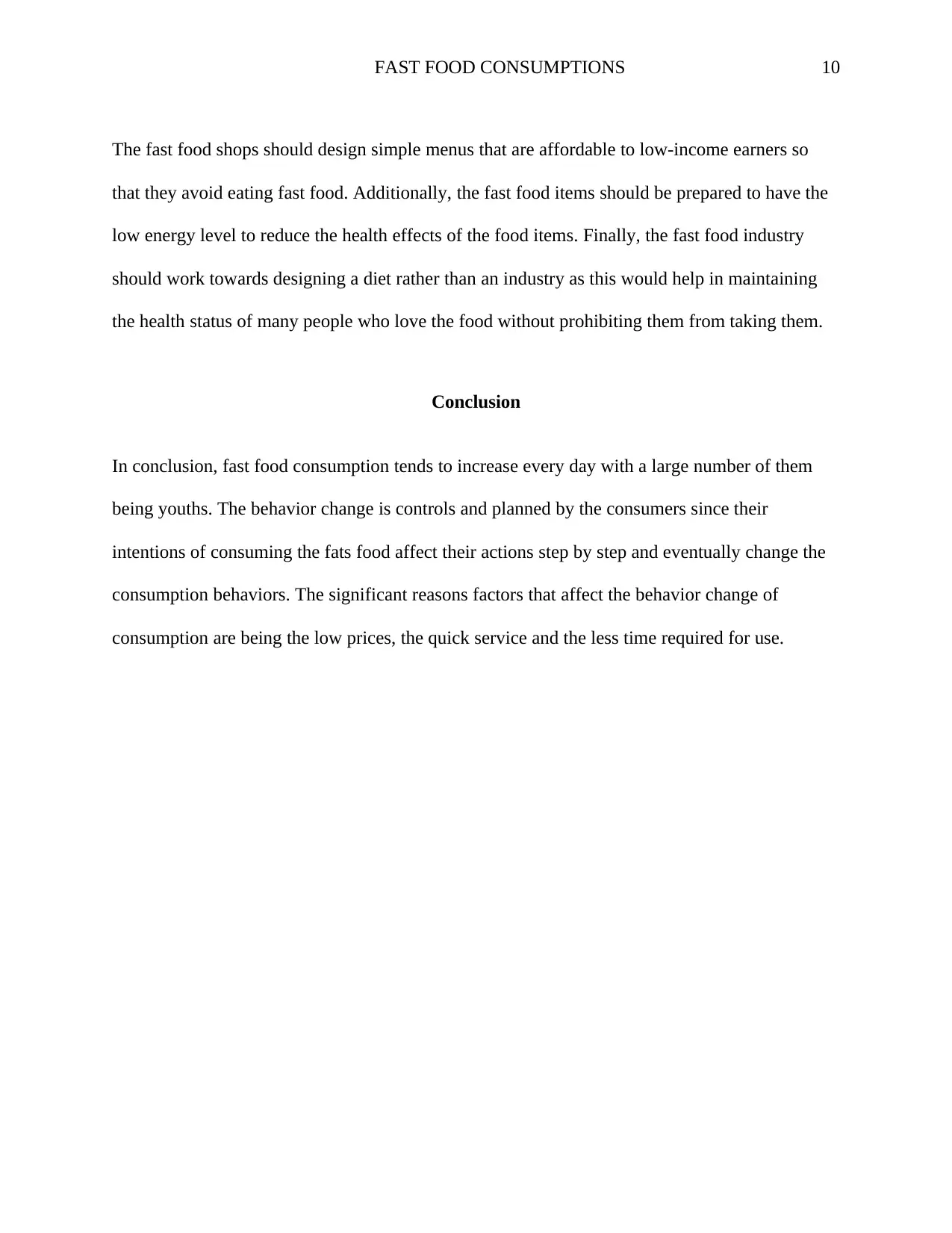
FAST FOOD CONSUMPTIONS 10
The fast food shops should design simple menus that are affordable to low-income earners so
that they avoid eating fast food. Additionally, the fast food items should be prepared to have the
low energy level to reduce the health effects of the food items. Finally, the fast food industry
should work towards designing a diet rather than an industry as this would help in maintaining
the health status of many people who love the food without prohibiting them from taking them.
Conclusion
In conclusion, fast food consumption tends to increase every day with a large number of them
being youths. The behavior change is controls and planned by the consumers since their
intentions of consuming the fats food affect their actions step by step and eventually change the
consumption behaviors. The significant reasons factors that affect the behavior change of
consumption are being the low prices, the quick service and the less time required for use.
The fast food shops should design simple menus that are affordable to low-income earners so
that they avoid eating fast food. Additionally, the fast food items should be prepared to have the
low energy level to reduce the health effects of the food items. Finally, the fast food industry
should work towards designing a diet rather than an industry as this would help in maintaining
the health status of many people who love the food without prohibiting them from taking them.
Conclusion
In conclusion, fast food consumption tends to increase every day with a large number of them
being youths. The behavior change is controls and planned by the consumers since their
intentions of consuming the fats food affect their actions step by step and eventually change the
consumption behaviors. The significant reasons factors that affect the behavior change of
consumption are being the low prices, the quick service and the less time required for use.
Paraphrase This Document
Need a fresh take? Get an instant paraphrase of this document with our AI Paraphraser

FAST FOOD CONSUMPTIONS 11
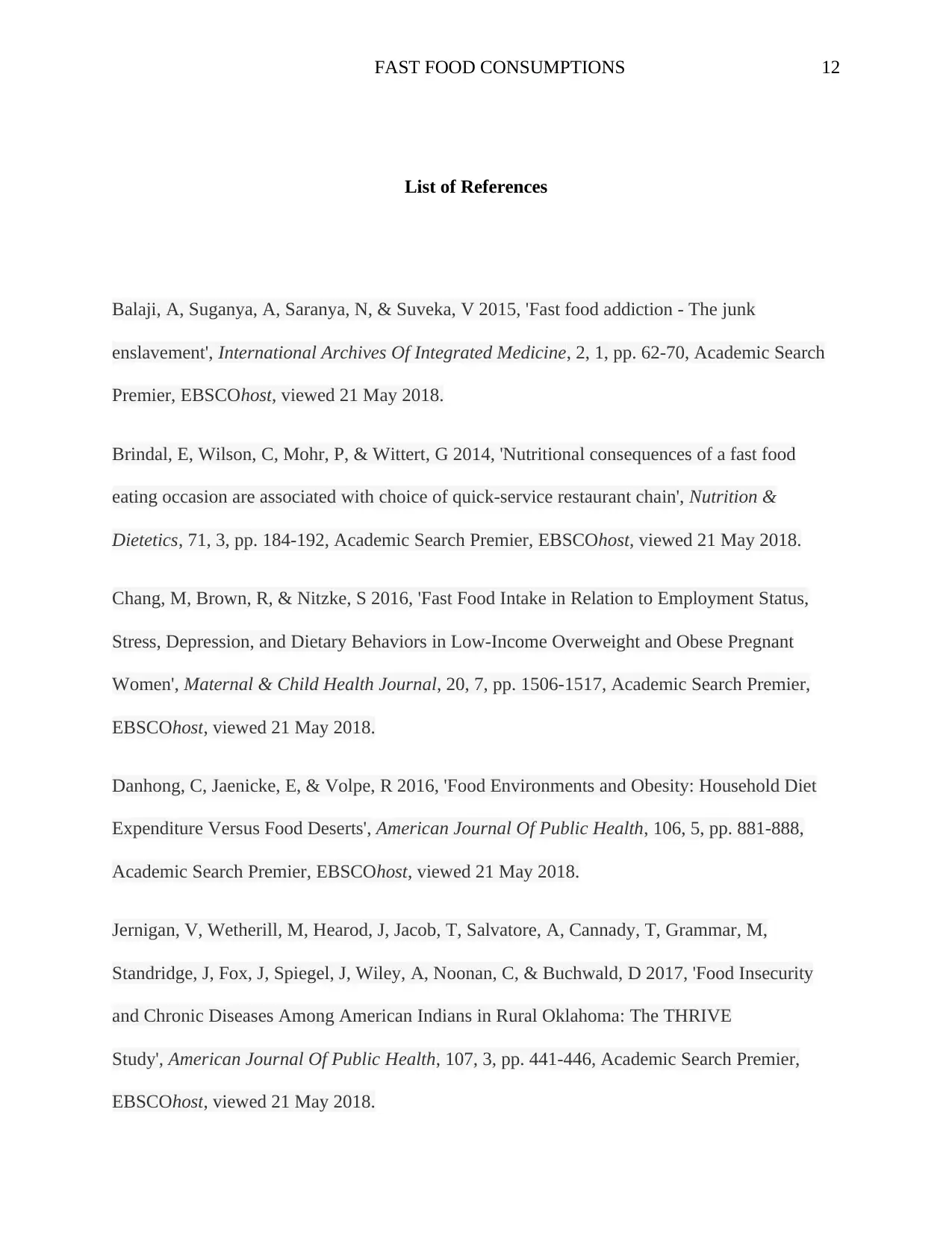
FAST FOOD CONSUMPTIONS 12
List of References
Balaji, A, Suganya, A, Saranya, N, & Suveka, V 2015, 'Fast food addiction - The junk
enslavement', International Archives Of Integrated Medicine, 2, 1, pp. 62-70, Academic Search
Premier, EBSCOhost, viewed 21 May 2018.
Brindal, E, Wilson, C, Mohr, P, & Wittert, G 2014, 'Nutritional consequences of a fast food
eating occasion are associated with choice of quick-service restaurant chain', Nutrition &
Dietetics, 71, 3, pp. 184-192, Academic Search Premier, EBSCOhost, viewed 21 May 2018.
Chang, M, Brown, R, & Nitzke, S 2016, 'Fast Food Intake in Relation to Employment Status,
Stress, Depression, and Dietary Behaviors in Low-Income Overweight and Obese Pregnant
Women', Maternal & Child Health Journal, 20, 7, pp. 1506-1517, Academic Search Premier,
EBSCOhost, viewed 21 May 2018.
Danhong, C, Jaenicke, E, & Volpe, R 2016, 'Food Environments and Obesity: Household Diet
Expenditure Versus Food Deserts', American Journal Of Public Health, 106, 5, pp. 881-888,
Academic Search Premier, EBSCOhost, viewed 21 May 2018.
Jernigan, V, Wetherill, M, Hearod, J, Jacob, T, Salvatore, A, Cannady, T, Grammar, M,
Standridge, J, Fox, J, Spiegel, J, Wiley, A, Noonan, C, & Buchwald, D 2017, 'Food Insecurity
and Chronic Diseases Among American Indians in Rural Oklahoma: The THRIVE
Study', American Journal Of Public Health, 107, 3, pp. 441-446, Academic Search Premier,
EBSCOhost, viewed 21 May 2018.
List of References
Balaji, A, Suganya, A, Saranya, N, & Suveka, V 2015, 'Fast food addiction - The junk
enslavement', International Archives Of Integrated Medicine, 2, 1, pp. 62-70, Academic Search
Premier, EBSCOhost, viewed 21 May 2018.
Brindal, E, Wilson, C, Mohr, P, & Wittert, G 2014, 'Nutritional consequences of a fast food
eating occasion are associated with choice of quick-service restaurant chain', Nutrition &
Dietetics, 71, 3, pp. 184-192, Academic Search Premier, EBSCOhost, viewed 21 May 2018.
Chang, M, Brown, R, & Nitzke, S 2016, 'Fast Food Intake in Relation to Employment Status,
Stress, Depression, and Dietary Behaviors in Low-Income Overweight and Obese Pregnant
Women', Maternal & Child Health Journal, 20, 7, pp. 1506-1517, Academic Search Premier,
EBSCOhost, viewed 21 May 2018.
Danhong, C, Jaenicke, E, & Volpe, R 2016, 'Food Environments and Obesity: Household Diet
Expenditure Versus Food Deserts', American Journal Of Public Health, 106, 5, pp. 881-888,
Academic Search Premier, EBSCOhost, viewed 21 May 2018.
Jernigan, V, Wetherill, M, Hearod, J, Jacob, T, Salvatore, A, Cannady, T, Grammar, M,
Standridge, J, Fox, J, Spiegel, J, Wiley, A, Noonan, C, & Buchwald, D 2017, 'Food Insecurity
and Chronic Diseases Among American Indians in Rural Oklahoma: The THRIVE
Study', American Journal Of Public Health, 107, 3, pp. 441-446, Academic Search Premier,
EBSCOhost, viewed 21 May 2018.
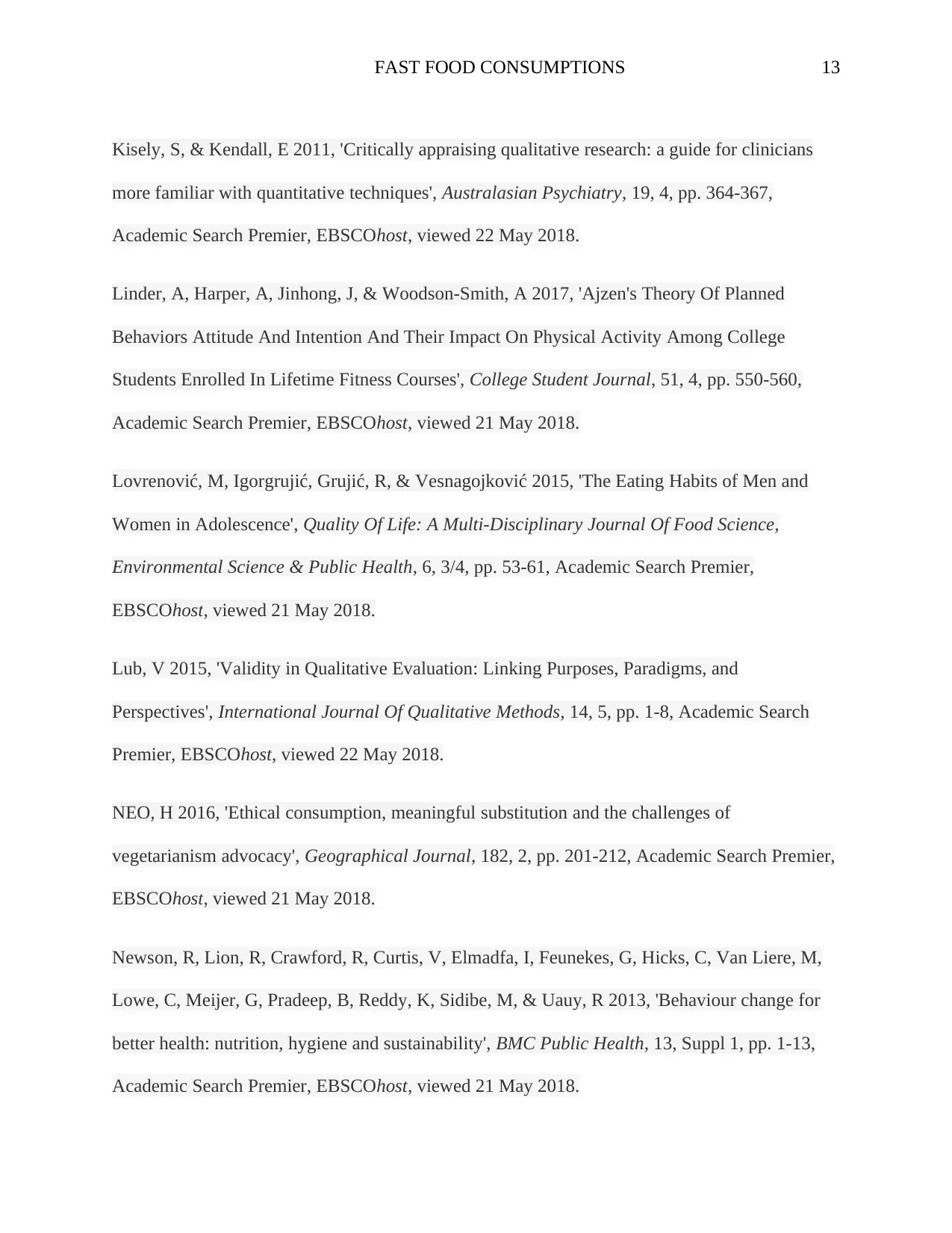
FAST FOOD CONSUMPTIONS 13
Kisely, S, & Kendall, E 2011, 'Critically appraising qualitative research: a guide for clinicians
more familiar with quantitative techniques', Australasian Psychiatry, 19, 4, pp. 364-367,
Academic Search Premier, EBSCOhost, viewed 22 May 2018.
Linder, A, Harper, A, Jinhong, J, & Woodson-Smith, A 2017, 'Ajzen's Theory Of Planned
Behaviors Attitude And Intention And Their Impact On Physical Activity Among College
Students Enrolled In Lifetime Fitness Courses', College Student Journal, 51, 4, pp. 550-560,
Academic Search Premier, EBSCOhost, viewed 21 May 2018.
Lovrenović, M, Igorgrujić, Grujić, R, & Vesnagojković 2015, 'The Eating Habits of Men and
Women in Adolescence', Quality Of Life: A Multi-Disciplinary Journal Of Food Science,
Environmental Science & Public Health, 6, 3/4, pp. 53-61, Academic Search Premier,
EBSCOhost, viewed 21 May 2018.
Lub, V 2015, 'Validity in Qualitative Evaluation: Linking Purposes, Paradigms, and
Perspectives', International Journal Of Qualitative Methods, 14, 5, pp. 1-8, Academic Search
Premier, EBSCOhost, viewed 22 May 2018.
NEO, H 2016, 'Ethical consumption, meaningful substitution and the challenges of
vegetarianism advocacy', Geographical Journal, 182, 2, pp. 201-212, Academic Search Premier,
EBSCOhost, viewed 21 May 2018.
Newson, R, Lion, R, Crawford, R, Curtis, V, Elmadfa, I, Feunekes, G, Hicks, C, Van Liere, M,
Lowe, C, Meijer, G, Pradeep, B, Reddy, K, Sidibe, M, & Uauy, R 2013, 'Behaviour change for
better health: nutrition, hygiene and sustainability', BMC Public Health, 13, Suppl 1, pp. 1-13,
Academic Search Premier, EBSCOhost, viewed 21 May 2018.
Kisely, S, & Kendall, E 2011, 'Critically appraising qualitative research: a guide for clinicians
more familiar with quantitative techniques', Australasian Psychiatry, 19, 4, pp. 364-367,
Academic Search Premier, EBSCOhost, viewed 22 May 2018.
Linder, A, Harper, A, Jinhong, J, & Woodson-Smith, A 2017, 'Ajzen's Theory Of Planned
Behaviors Attitude And Intention And Their Impact On Physical Activity Among College
Students Enrolled In Lifetime Fitness Courses', College Student Journal, 51, 4, pp. 550-560,
Academic Search Premier, EBSCOhost, viewed 21 May 2018.
Lovrenović, M, Igorgrujić, Grujić, R, & Vesnagojković 2015, 'The Eating Habits of Men and
Women in Adolescence', Quality Of Life: A Multi-Disciplinary Journal Of Food Science,
Environmental Science & Public Health, 6, 3/4, pp. 53-61, Academic Search Premier,
EBSCOhost, viewed 21 May 2018.
Lub, V 2015, 'Validity in Qualitative Evaluation: Linking Purposes, Paradigms, and
Perspectives', International Journal Of Qualitative Methods, 14, 5, pp. 1-8, Academic Search
Premier, EBSCOhost, viewed 22 May 2018.
NEO, H 2016, 'Ethical consumption, meaningful substitution and the challenges of
vegetarianism advocacy', Geographical Journal, 182, 2, pp. 201-212, Academic Search Premier,
EBSCOhost, viewed 21 May 2018.
Newson, R, Lion, R, Crawford, R, Curtis, V, Elmadfa, I, Feunekes, G, Hicks, C, Van Liere, M,
Lowe, C, Meijer, G, Pradeep, B, Reddy, K, Sidibe, M, & Uauy, R 2013, 'Behaviour change for
better health: nutrition, hygiene and sustainability', BMC Public Health, 13, Suppl 1, pp. 1-13,
Academic Search Premier, EBSCOhost, viewed 21 May 2018.
Secure Best Marks with AI Grader
Need help grading? Try our AI Grader for instant feedback on your assignments.
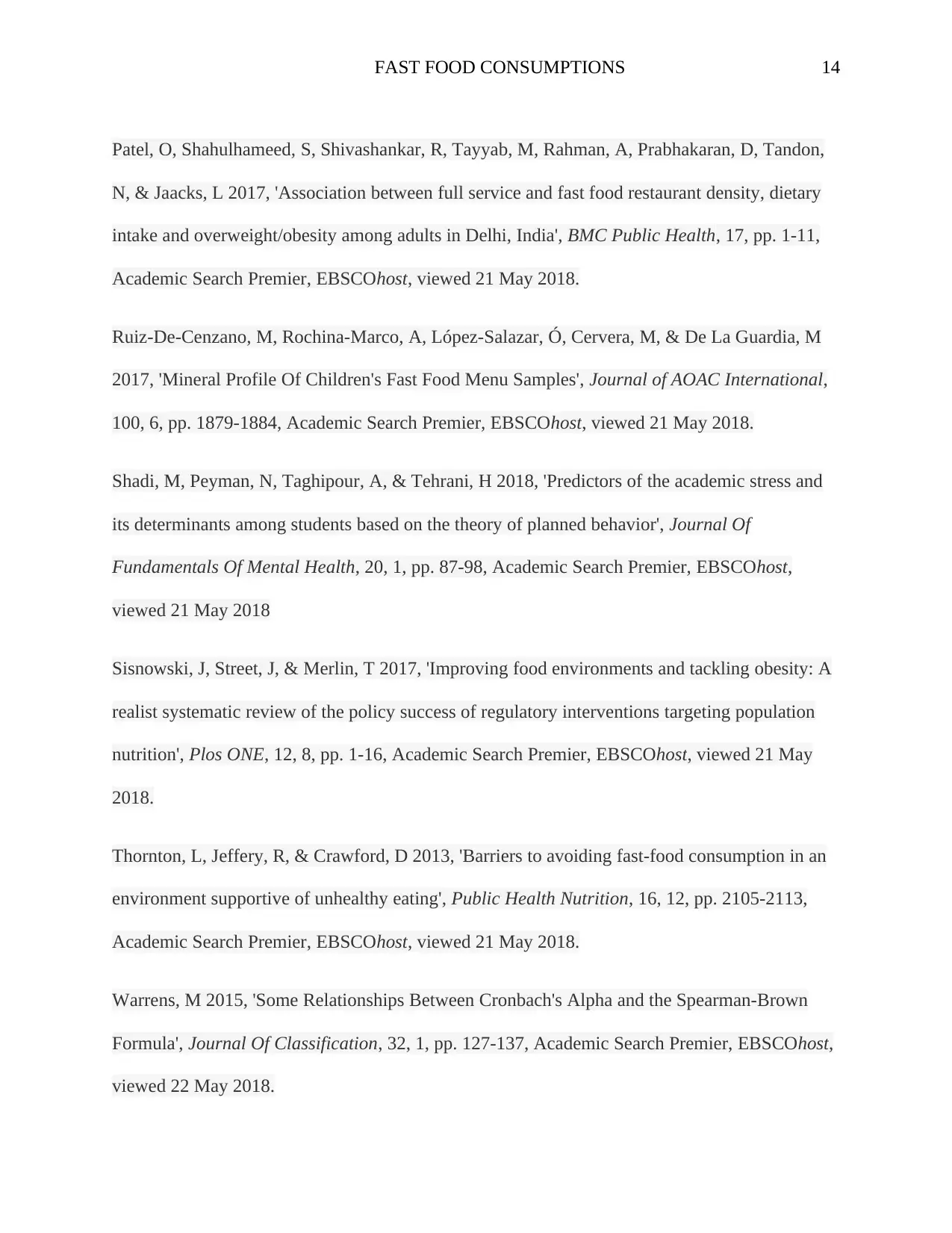
FAST FOOD CONSUMPTIONS 14
Patel, O, Shahulhameed, S, Shivashankar, R, Tayyab, M, Rahman, A, Prabhakaran, D, Tandon,
N, & Jaacks, L 2017, 'Association between full service and fast food restaurant density, dietary
intake and overweight/obesity among adults in Delhi, India', BMC Public Health, 17, pp. 1-11,
Academic Search Premier, EBSCOhost, viewed 21 May 2018.
Ruiz-De-Cenzano, M, Rochina-Marco, A, López-Salazar, Ó, Cervera, M, & De La Guardia, M
2017, 'Mineral Profile Of Children's Fast Food Menu Samples', Journal of AOAC International,
100, 6, pp. 1879-1884, Academic Search Premier, EBSCOhost, viewed 21 May 2018.
Shadi, M, Peyman, N, Taghipour, A, & Tehrani, H 2018, 'Predictors of the academic stress and
its determinants among students based on the theory of planned behavior', Journal Of
Fundamentals Of Mental Health, 20, 1, pp. 87-98, Academic Search Premier, EBSCOhost,
viewed 21 May 2018
Sisnowski, J, Street, J, & Merlin, T 2017, 'Improving food environments and tackling obesity: A
realist systematic review of the policy success of regulatory interventions targeting population
nutrition', Plos ONE, 12, 8, pp. 1-16, Academic Search Premier, EBSCOhost, viewed 21 May
2018.
Thornton, L, Jeffery, R, & Crawford, D 2013, 'Barriers to avoiding fast-food consumption in an
environment supportive of unhealthy eating', Public Health Nutrition, 16, 12, pp. 2105-2113,
Academic Search Premier, EBSCOhost, viewed 21 May 2018.
Warrens, M 2015, 'Some Relationships Between Cronbach's Alpha and the Spearman-Brown
Formula', Journal Of Classification, 32, 1, pp. 127-137, Academic Search Premier, EBSCOhost,
viewed 22 May 2018.
Patel, O, Shahulhameed, S, Shivashankar, R, Tayyab, M, Rahman, A, Prabhakaran, D, Tandon,
N, & Jaacks, L 2017, 'Association between full service and fast food restaurant density, dietary
intake and overweight/obesity among adults in Delhi, India', BMC Public Health, 17, pp. 1-11,
Academic Search Premier, EBSCOhost, viewed 21 May 2018.
Ruiz-De-Cenzano, M, Rochina-Marco, A, López-Salazar, Ó, Cervera, M, & De La Guardia, M
2017, 'Mineral Profile Of Children's Fast Food Menu Samples', Journal of AOAC International,
100, 6, pp. 1879-1884, Academic Search Premier, EBSCOhost, viewed 21 May 2018.
Shadi, M, Peyman, N, Taghipour, A, & Tehrani, H 2018, 'Predictors of the academic stress and
its determinants among students based on the theory of planned behavior', Journal Of
Fundamentals Of Mental Health, 20, 1, pp. 87-98, Academic Search Premier, EBSCOhost,
viewed 21 May 2018
Sisnowski, J, Street, J, & Merlin, T 2017, 'Improving food environments and tackling obesity: A
realist systematic review of the policy success of regulatory interventions targeting population
nutrition', Plos ONE, 12, 8, pp. 1-16, Academic Search Premier, EBSCOhost, viewed 21 May
2018.
Thornton, L, Jeffery, R, & Crawford, D 2013, 'Barriers to avoiding fast-food consumption in an
environment supportive of unhealthy eating', Public Health Nutrition, 16, 12, pp. 2105-2113,
Academic Search Premier, EBSCOhost, viewed 21 May 2018.
Warrens, M 2015, 'Some Relationships Between Cronbach's Alpha and the Spearman-Brown
Formula', Journal Of Classification, 32, 1, pp. 127-137, Academic Search Premier, EBSCOhost,
viewed 22 May 2018.
1 out of 14
Related Documents
Your All-in-One AI-Powered Toolkit for Academic Success.
+13062052269
info@desklib.com
Available 24*7 on WhatsApp / Email
![[object Object]](/_next/static/media/star-bottom.7253800d.svg)
Unlock your academic potential
© 2024 | Zucol Services PVT LTD | All rights reserved.





